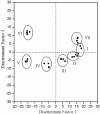Volatile organic compound emissions from different stages of Cananga odorata flower development
- PMID: 24979401
- PMCID: PMC6270805
- DOI: 10.3390/molecules19078965
Volatile organic compound emissions from different stages of Cananga odorata flower development
Abstract
Headspace-solid phase microextraction-gas chromatography-mass spectrometry (HS-SPME-GC-MS) was used to identify the volatile organic compounds (VOCs) of the different flower development stages of Cananga odorata for the evaluation of floral volatile polymorphism as a basis to determine the best time of harvest. Electronic nose results, coupled with discriminant factor analysis, suggested that emitted odors varied in different C. odorata flower development stages, including the bud, display-petal, initial-flowering, full-flowering, end-flowering, wilted-flower, and dried flower stages. The first two discriminant factors explained 97.52% of total system variance. Ninety-two compounds were detected over the flower life, and the mean Bray-Curtis similarity value was 52.45% among different flower development stages. A high level of volatile polymorphism was observed during flower development. The VOCs were largely grouped as hydrocarbons, esters, alcohols, aldehydes, phenols, acids, ketones, and ethers, and the main compound was β-caryophyllene (15.05%-33.30%). Other identified compounds were β-cubebene, D-germacrene, benzyl benzoate, and α-cubebene. Moreover, large numbers of VOCs were detected at intermediate times of flower development, and more hydrocarbons, esters, and alcohols were identified in the full-flowering stage. The full-flowering stage may be the most suitable period for C. odorata flower harvest.
Conflict of interest statement
The authors declare no conflict of interest.
Figures




Similar articles
-
Variation in the Floral Scent Chemistry of Nymphaea 'Eldorado', a Valuable Water Lily, with Different Flowering Stages and Flower Parts.Plants (Basel). 2024 Mar 24;13(7):939. doi: 10.3390/plants13070939. Plants (Basel). 2024. PMID: 38611469 Free PMC article.
-
Volatile Organic Compounds Emissions from Luculia pinceana Flower and Its Changes at Different Stages of Flower Development.Molecules. 2016 Apr 22;21(4):531. doi: 10.3390/molecules21040531. Molecules. 2016. PMID: 27110758 Free PMC article.
-
The floral transcriptome of ylang ylang (Cananga odorata var. fruticosa) uncovers biosynthetic pathways for volatile organic compounds and a multifunctional and novel sesquiterpene synthase.J Exp Bot. 2015 Jul;66(13):3959-75. doi: 10.1093/jxb/erv196. Epub 2015 May 8. J Exp Bot. 2015. PMID: 25956881 Free PMC article.
-
[Recent advances in the application of headspace gas chromatography-mass spectrometry].Se Pu. 2018 Oct 8;36(10):962-971. doi: 10.3724/SP.J.1123.2018.05013. Se Pu. 2018. PMID: 30378354 Review. Chinese.
-
Odors and cancer: Current status and future directions.Biochim Biophys Acta Rev Cancer. 2022 Jan;1877(1):188644. doi: 10.1016/j.bbcan.2021.188644. Epub 2021 Nov 1. Biochim Biophys Acta Rev Cancer. 2022. PMID: 34737023 Review.
Cited by
-
Variation in the Floral Scent Chemistry of Nymphaea 'Eldorado', a Valuable Water Lily, with Different Flowering Stages and Flower Parts.Plants (Basel). 2024 Mar 24;13(7):939. doi: 10.3390/plants13070939. Plants (Basel). 2024. PMID: 38611469 Free PMC article.
-
Floral Scent Chemistry of Luculia yunnanensis (Rubiaceae), a Species Endemic to China with Sweetly Fragrant Flowers.Molecules. 2017 May 25;22(6):879. doi: 10.3390/molecules22060879. Molecules. 2017. PMID: 28587077 Free PMC article.
-
Traditional Uses, Phytochemistry, and Bioactivities of Cananga odorata (Ylang-Ylang).Evid Based Complement Alternat Med. 2015;2015:896314. doi: 10.1155/2015/896314. Epub 2015 Jul 30. Evid Based Complement Alternat Med. 2015. PMID: 26294929 Free PMC article. Review.
-
Biologically Active Compounds of Malaysian Medicinal and Aromatic Plants.Prog Chem Org Nat Prod. 2025;127:1-202. doi: 10.1007/978-3-031-86378-3_1. Prog Chem Org Nat Prod. 2025. PMID: 40652426 Review.
-
Olfactory Exposure to β-Caryophyllene Increases Testosterone Levels in Women's Saliva.Sex Med. 2020 Sep;8(3):525-531. doi: 10.1016/j.esxm.2020.06.001. Epub 2020 Jun 16. Sex Med. 2020. PMID: 32561330 Free PMC article.
References
-
- Kristiawan M., Sobolik V., Allaf K. Isolation of Indonesian cananga oil using multi-cycle pressure drop process. J. Chromatogr. A. 2008;1192:306–318. - PubMed
-
- Benini C., Ringuet M., Wathelet J.P., Lognay G., du Jardin P., Fauconnier M.L. Variations in the essential oils from ylang-ylang (Cananga odorata [Lam.] Hook f. & Thomson forma genuina) in the Western Indian Ocean islands. Flavour Frag. J. 2012;27:356–366. doi: 10.1002/ffj.3106. - DOI
-
- Benini C., Danflous J.P., Wathelet J.P., du Jardin P., Fauconnier M.L. Ylang-ylang [Cananga odorata (Lam.) Hook. f. & Thomson]: An unknown essential oil plant in an endangered sector. Biotechnol. Agron. Soc. 2010;14:693–705.
Publication types
MeSH terms
Substances
LinkOut - more resources
Full Text Sources
Other Literature Sources
Miscellaneous

